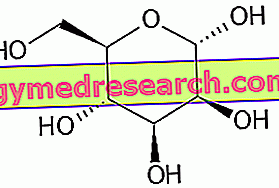D-mannose is a simple sugar, a six-carbon monosaccharide that frequently enters the composition of plant polymers.

Recently, mannose has been proposed as a natural remedy against cystitis, an alternative to antibiotics and their side effects. Let's find out why.
Mannose, which is why it can be extremely useful in the presence of cystitis
Cystitis is an inflammation of the bladder mucosa, sustained - most of the time - by bacteria, in particular by optional anaerobic strains that derive from the intestinal bacterial flora. Among these, the most common and known is undoubtedly Escherichia Coli, which is estimated to be responsible for 85% of outpatient infections and 50% of hospital infections. Observed under the microscope, this bacterium has filamentous appendages on its surface, functionally comparable to tentacles. In fact, thanks to these structures called fimbriae or pili, bacteria can adhere to epithelial cells and colonize tissues (exploiting protein molecules, called adhesins or lectins, located at the ends of pili).
On the basis of mannose's ability to interfere with microbial adhesion, two main types of pili are distinguished, mannose-sensitive (or type I) and mannose-resistant (or type P). Sensitive mannose fimbriae are present on the surface of many E.Coli responsible for urinary infections, such as cystitis. However, some of these microorganisms have developed pili with adhesive mechanisms independent of mannose. This natural evolution is probably dictated by the ability of the urinary mucosa to actively secrete glycoproteins with mannose residues, which bind avidly to type I pili by counteracting the engraftment of the pathogen and favoring urinary elimination. In fact, the bacteria adhere to it through specific receptors, thus saturating the possible sites of binding to the bladder mucosa and significantly reducing the adhesion capacity
Tamm-Horsfall protein (uromodulin) is a glycoprotein containing mannose produced by the kidney and excreted in large quantities in the urine; some bacteria bind avidly to it and this prevents the colonization of the urinary tract by them.
Putting together what has been said so far, it is clear that if mannose:
it is mainly excreted in the urine
and it avidly binds to bacterial pili, blocking its attachment to the bladder mucosa
it represents, at least in theory, an excellent remedy against cystitis. Not by chance, the anti-adhesive properties of the American cranberry ( Vaccinium macrocarpon useful natural remedy against cystitis) are often traced to the generous presence of mannose.
Mannose also enters the composition of the so-called mannano-oligosaccharides (MOS), which, taken orally, have shown bifidogenic properties (they are therefore prebiotics). These substances are able to overcome the small intestine absorbed, reaching the last districts of the intestine where they are hydrolyzed and used on the spot by the bacterial flora. At this level they can therefore influence the digestive microflora as a favorable substrate for useful enterobacteria, neutralizing part of the pathogens and enhancing the body's defense powers (as shown by the increase in plasma immunoglobulins recorded in various studies that have investigated the effectiveness of a supplementation with prebiotics). Mannan-oligosaccharides, thanks to the presence of mannose, also seem to exert an antibiotic activity directed at the enteric level, following in this sense the same anti-colonizing mechanism (mannose VS adhesins) seen at bladder level. Normally, in fact, bacterial cells with mannose specific pili attach to mannose-containing cells in the intestinal tract.
By favoring the establishment of a friendly intestinal flora, to the detriment of the pathogenic one, the integration of mannose could be further beneficial in the prevention of cystitis, which in many cases we know is caused precisely by the bladder colonization of fecal bacteria (such as the Escherichia Coli).
Dietary Mannose, side effects and dosages used in the fight against cystitis
Mannose is included in the diet in limited quantities; we find it in small concentrations in fruit (pears, apples, oranges ...) as free monosaccharide, and in food glycoproteins in complex form.
The conditional used in the article with reference to the antibacterial properties of mannose appears to be at least a duty, since this sugar is not yet used by official medicine in the treatment of cystitis. It is therefore difficult to pronounce on dosages and possible side effects, even if - since it is a substance commonly present in the diet, as well as synthesized by the human organism - the latter should be limited. The available evidence on absorption and elimination kinetics suggest possible side effects at gastro-intestinal level (flatulence, diarrhea, meteorism) and renal (contraindicated in case of kidney disease).
The dosages of mannose normally suggested in the treatment of cystitis vary from one to 2.5 grams per day (from one to two teaspoons), to be taken possibly together with generous amounts of water to take advantage of the washing effect thereof. In any case, before using mannose to fight cystitis, it is advisable to obtain the clearance from your doctor.



